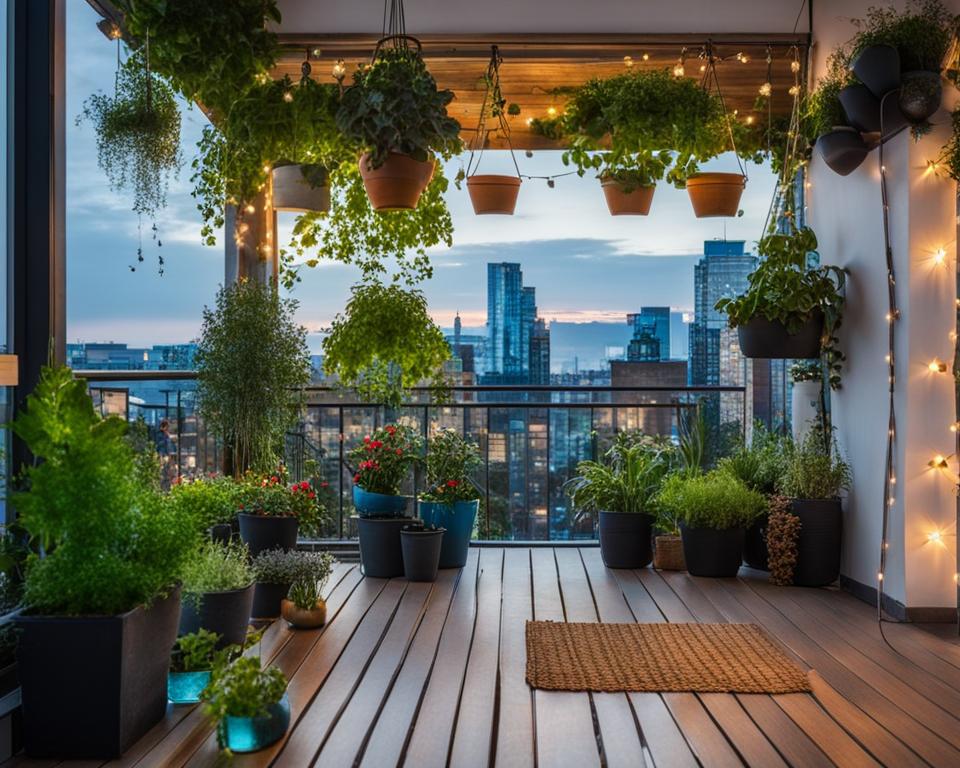Welcome to my guide on urban gardening for your home! If you have a small living space and are looking to bring some greenery into your life, urban gardening is the perfect solution. Whether you have a balcony, terrace, porch, or even just a small patch of dirt, you can transform it into a lush urban garden that adds beauty and a touch of nature to your home. In this guide, I will share tips and techniques on how to effectively utilize your space, choose the right plants, overcome challenges, and make urban gardening affordable. Let’s dive in and discover the joy of green living!
Choosing the Right Plants for Your Urban Garden
When it comes to urban gardening, choosing the right plants is essential for creating a thriving green space in your home. Whether you have a balcony, rooftop, or a small patch of dirt, selecting plants that are suitable for your limited space is key. Look for plants labeled as “dwarf” or “miniature” as they have smaller footprints, allowing you to maximize your available area.
To add height and visual interest to your urban garden, consider plants with tall silhouettes. Columnar apple trees or the beautiful Baptisia australis with its violet-blue flowers are excellent choices. These plants not only take up less ground space but also create a vertical element in your garden, making it visually appealing.
Vertical gardening is another technique that can help you make the most of your limited space. Using green walls, you can grow plants vertically, freeing up ground space and adding a unique and lush look to your urban garden.
| Shade | Sun |
|---|---|
|
|
Considering your local conditions, such as sunlight availability, is crucial when selecting plants for your urban garden. For shady areas, plants like fuchsia and impatiens thrive, while sunny spots can accommodate plants like petunias, salvia, and geraniums. Don’t forget about the potential of growing vegetables in containers, as they not only add color to your garden but also provide you with fresh and nutritious produce.
Choosing the Right Plants: Summary
- Opt for plants labeled as “dwarf” or “miniature” to maximize your available space.
- Select plants with tall silhouettes to create a vertical element and add visual interest.
- Consider vertical gardening techniques, such as green walls, to make the most of limited space.
- Choose plants based on your local conditions, such as sunlight availability.
- For shady areas, opt for plants like fuchsia and impatiens, while sunny spots can accommodate petunias, salvia, and geraniums.
- Don’t overlook the potential of growing vegetables in containers to add both color and nutritious produce to your urban garden.
Overcoming Challenges in Urban Gardening
Urban gardening is a rewarding endeavor, but it also comes with its fair share of challenges. In small living spaces like high-rise buildings, rooftop gardens and balconies can be exposed to strong winds, radiant heat from concrete, and shade from neighboring buildings. However, with some strategic planning and the right plant selection, you can overcome these challenges and create a thriving urban garden.
To withstand gusts of wind, choose plants known for their hardiness and slow growth. Nasturtium and daylilies are excellent options as they have flexible stems that can sway without breaking. Consider adding a lattice windbreak, not only for protection but also to add a stylish element to your garden. Furthermore, pollution is a common issue in urban areas, so opt for plants with shiny leaves that won’t trap dust, such as morning glory vines, coleus, zinnias, and marigolds.
It’s important to keep in mind that plants in street-level plots may need occasional replacement due to car or foot traffic. However, the benefits of urban gardening, such as the shading, beauty, privacy, and sense of community it brings, far outweigh these challenges. By selecting resilient plants, implementing protective measures, and embracing the unique characteristics of urban environments, you can successfully overcome the obstacles and create a thriving urban garden.
Overcoming Challenges in Urban Gardening
| Challenge | Solution |
|---|---|
| Strong winds | Choose hardy plants with flexible stems like nasturtium and daylilies. Use a lattice windbreak for protection. |
| Pollution | Opt for plants with shiny leaves that won’t trap dust, such as morning glory vines, coleus, zinnias, and marigolds. |
| Car or foot traffic | Accept that plants in street-level plots may need occasional replacement. Focus on the benefits of urban gardening, such as shading, beauty, privacy, and community. |
By addressing these challenges head-on and using smart gardening techniques, you can create a flourishing urban garden even in the face of adversity. Embrace the resilience of urban gardening and let your creativity flourish in transforming your small space into a green oasis.
Making Urban Gardening Affordable
Creating an urban garden doesn’t have to be expensive. With some resourcefulness and thrifty strategies, you can pursue your passion for urban gardening without breaking the bank. By optimizing your budget and taking advantage of cost-saving opportunities, you can achieve a sustainable and affordable urban garden.
Sourcing Affordable Supplies
When it comes to purchasing supplies for your urban garden, there are ways to save money without compromising on quality. One cost-saving option is to organize a seed swap with friends and neighbors. This allows you to exchange seeds and expand your plant variety at no extra cost. Additionally, reach out to local cooperative extension offices, as they often provide free supplies such as mulch.
Municipalities also offer programs that can help reduce expenses. Look for workshops and rebates for items like trees, rain barrels, compost bins, and native plants. These programs not only offer cost savings but also provide opportunities to learn about sustainable gardening practices from experts.
Budget-Friendly Gardening Tools
To keep your gardening expenses low, prioritize essential tools and invest in quality, durable options. Basic tools such as a hand trowel, pruners, and a hose are essential for urban gardening and can be found at affordable prices. Opting for long-lasting tools will save you money in the long run, as you won’t need to replace them frequently.
Utilizing Low-Cost Containers
Choosing the right containers for your urban garden can also help you stay within your budget. Look for low-cost containers such as repurposed plastic buckets, wooden crates, or even old tires. These alternatives are often readily available and can be transformed into unique and eco-friendly planters. Remember to drill drainage holes in the bottom of the containers to ensure proper water drainage for your plants.
Summary
Making urban gardening affordable is achievable through careful planning and smart choices. By sourcing affordable supplies, taking advantage of municipal programs, investing in quality tools, and utilizing low-cost containers, you can create a sustainable and budget-friendly urban garden. Remember, with a little creativity and resourcefulness, you can transform your small space into a vibrant green oasis without breaking the bank.
The Brooklyn Urban Gardeners (BUGs) Program
Are you passionate about greening your community and want to take your urban gardening skills to the next level? Look no further than the Brooklyn Urban Gardeners (BUGs) program offered by the Brooklyn Botanic Garden (BBG). As an adult resident of Brooklyn, you can join this certification program for free and become part of a community of diverse individuals with a shared passion for gardening.
The BUGs program consists of a multi-session course that covers a wide range of topics, including community building, site assessment, and gardening with native plants. By attending all sessions, completing required reading and homework, and creating a portfolio of your work, you can graduate from the program as a certified BUG. Upon graduation, BUGs commit to volunteering at least 20 hours per year in community greening projects.
The Brooklyn Urban Gardeners (BUGs) program is managed by the community greening staff in the Education department of BBG. In addition to the BUGs program, BBG also oversees other community greening initiatives such as Making Brooklyn Bloom and the Greenest Block in Brooklyn contest. Join the BUGs program and become part of a thriving community dedicated to urban gardening and making a positive impact on Brooklyn’s green spaces.
Benefits of the Brooklyn Urban Gardeners (BUGs) Program
- Free certification program for adult residents of Brooklyn
- Multi-session course covering various gardening topics
- Opportunity to learn community building and site assessment skills
- Focus on gardening with native plants for a sustainable approach
- Volunteer opportunities in community greening projects
How to Join the Brooklyn Urban Gardeners (BUGs) Program
- Check your eligibility as an adult resident of Brooklyn
- Visit the Brooklyn Botanic Garden website for program details
- Fill out the application form and submit it online
- Attend an interview if selected
- Commit to attending all program sessions and completing required tasks
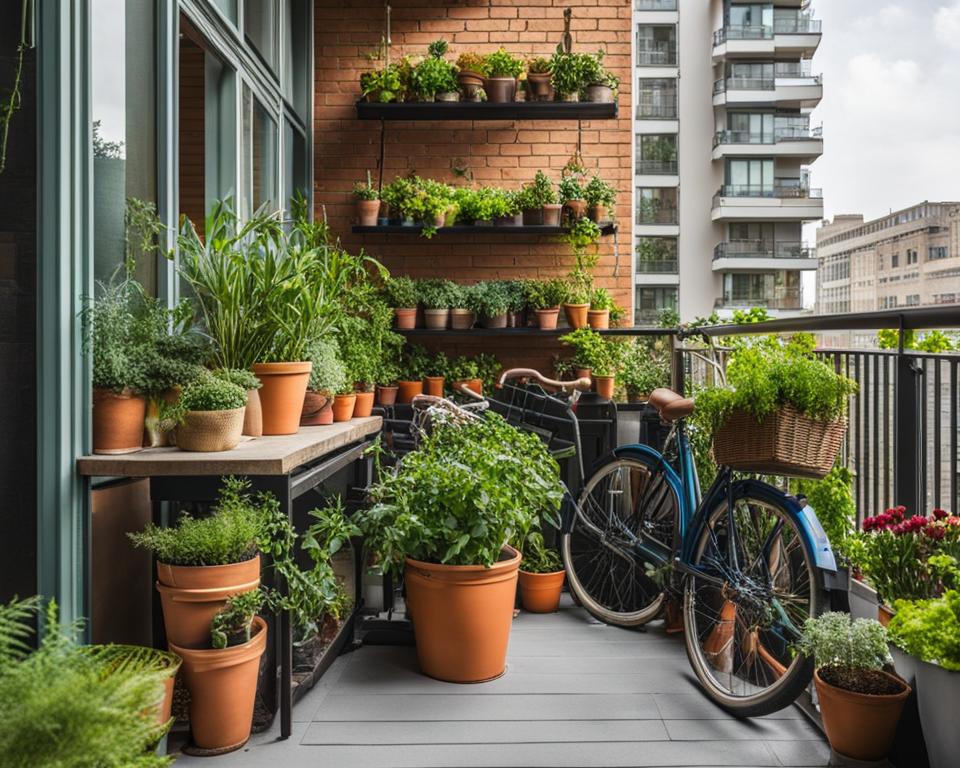
Testimonials from BUGs Program Graduates
The BUGs program has been an incredible journey for me. Not only did I learn valuable gardening techniques, but I also had the opportunity to connect with like-minded individuals who share my passion for greening our community. Volunteering in community greening projects has been rewarding and fulfilling. I highly recommend the BUGs program to anyone interested in urban gardening.
– Jenny, BUGs Program Graduate
Get Started with BUGs Program and Make a Difference
If you’re ready to take your urban gardening skills to the next level and make a difference in your community, join the Brooklyn Urban Gardeners (BUGs) program. By becoming a certified BUG, you’ll gain valuable knowledge, skills, and a network of fellow gardening enthusiasts. Together, we can create greener and more sustainable urban environments. Apply now and embark on a rewarding gardening journey with BUGs!
Sustainable Gardening Practices for Urban Gardens
Creating a sustainable urban garden is not only beneficial for the environment but also for the health and longevity of your plants. By adopting eco-friendly gardening practices, you can minimize your impact on the planet while still enjoying a vibrant and thriving garden. Here are some sustainable gardening practices that you can incorporate into your urban garden:
- Integrated Pest Management (IPM): Implementing IPM techniques can help control pests without relying on harmful pesticides. By attracting beneficial insects and using organic pest control methods, you can keep your garden healthy and pest-free.
- Composting and Vermicomposting: Instead of relying on chemical fertilizers, you can create natural plant fertilizers by composting organic waste. Vermicomposting, which involves using worms to break down organic material, is another effective way to produce nutrient-rich compost.
- Water Conservation: Conserving water is essential in urban gardening. You can use water-efficient watering techniques, such as drip irrigation or installing a rainwater harvesting system with rain barrels. Additionally, incorporating native plants and mulching can help retain moisture in the soil.
- Attracting Pollinators: Pollinators play a crucial role in plant reproduction and biodiversity. By planting flowers that provide nectar and pollen and avoiding the use of pesticides, you can attract bees, butterflies, and other pollinators to your garden.
By implementing these sustainable gardening practices, you can create an eco-friendly and thriving urban garden that benefits both you and the environment.
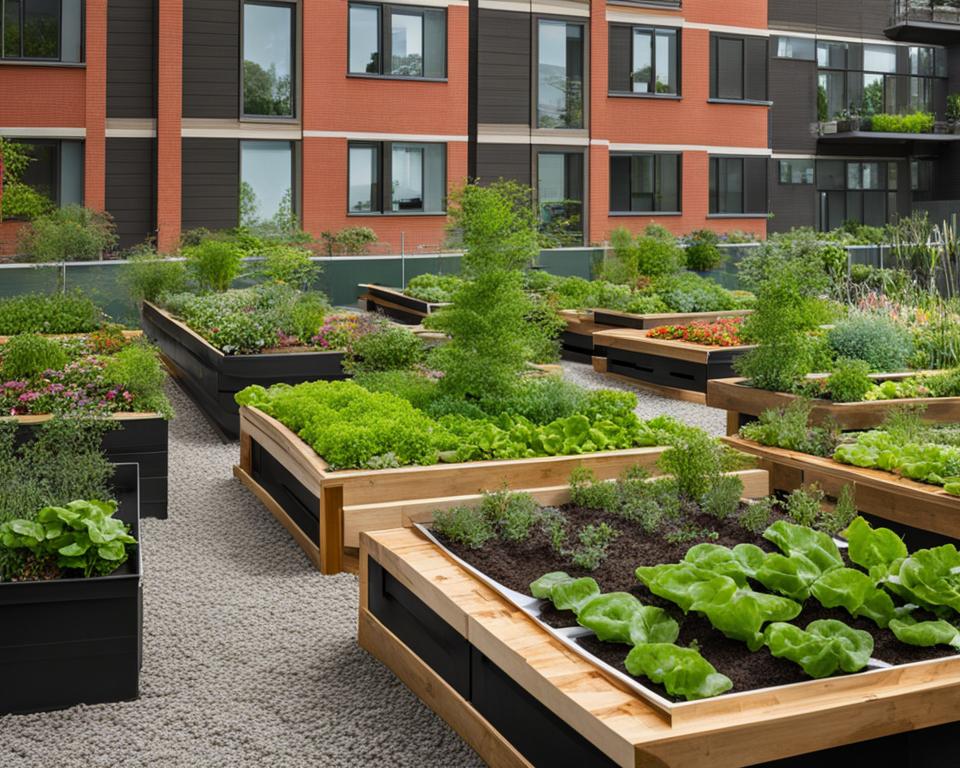
“The ultimate goal of sustainable urban gardening is to create a harmonious and balanced ecosystem that benefits both humans and nature.”
Comparing Traditional Gardening Methods with Sustainable Gardening Practices
| Traditional Gardening | Sustainable Gardening | |
|---|---|---|
| Water Usage | High water consumption due to inefficient watering techniques | Water-efficient practices, such as drip irrigation and rainwater harvesting |
| Pest Control | Reliance on chemical pesticides that can harm beneficial insects and pollinators | Integrated Pest Management (IPM) techniques that minimize pesticide use and attract beneficial insects |
| Soil Health | Limited focus on soil health, often relying on chemical fertilizers | Emphasis on improving soil health through composting and organic fertilizers |
| Biodiversity | Often limited to a few common plant species | Encourages the use of native plants to enhance biodiversity and support local ecosystems |
“Sustainable gardening practices not only benefit the environment but also contribute to the health and longevity of your plants, resulting in a more successful and resilient urban garden.”
Sustainable Urban Gardening: Water Conservation and Stormwater Management
In urban gardening, water conservation is a key aspect of sustainability. By implementing effective water conservation practices, you can minimize waste and ensure the longevity of your garden. Additionally, managing stormwater is crucial to prevent issues such as flooding and pollution. Let’s explore some strategies for conserving water and managing stormwater in your urban garden.
Water Conservation Techniques
To conserve water in your urban garden, consider the following techniques:
- Efficient watering methods: Use drip irrigation or soaker hoses to deliver water directly to the roots of plants, reducing evaporation and runoff.
- Mulching: Apply a layer of organic mulch around plants to retain moisture, suppress weeds, and regulate soil temperature.
- Rainwater harvesting: Install rain barrels or cisterns to collect rainwater for use in your garden. This reduces the need for potable water and saves money on your water bill.
Stormwater Management Strategies
Proper management of stormwater is essential in urban gardening. Here are some strategies to consider:
- Rain gardens: Create rain gardens in low-lying areas of your garden to capture and absorb stormwater. Plant native species with deep roots that can tolerate wet conditions.
- Permeable surfaces: Use permeable paving materials, such as gravel or porous concrete, to allow rainwater to infiltrate the ground instead of running off into storm drains.
- Vegetated swales: Construct vegetated swales or bioswales to collect and filter stormwater. These shallow, vegetated channels slow down the flow of water, allowing it to infiltrate the soil and remove pollutants.
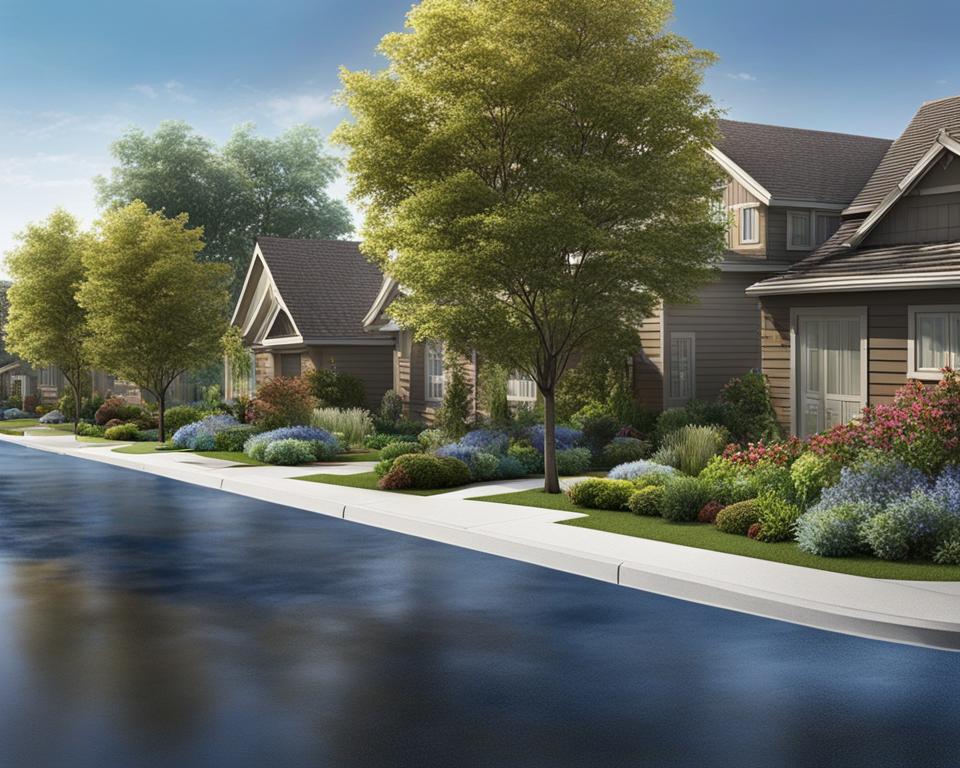
By incorporating these water conservation and stormwater management practices into your urban garden, you can minimize water waste, support a healthier ecosystem, and contribute to a more sustainable environment. Remember, every drop counts!
Attracting Pollinators and Beneficial Insects
Creating a pollinator-friendly garden is an essential aspect of sustainable urban gardening. By attracting pollinators and beneficial insects, you can enhance the biodiversity and ecological balance of your garden. Native plants are particularly effective in attracting pollinators, as they provide a familiar food source and habitat for local species. Consider planting flowers that provide nectar and pollen throughout the growing season, such as bee balm, coneflowers, and lavender.
Water sources are also important for pollinators, so providing a shallow dish with rocks or pebbles for them to land on and drink from can make a big difference. Additionally, incorporating nesting sites for bees and butterflies, such as bee boxes or butterfly houses, can further support their populations.
To create a visually engaging and informative table, let’s highlight some common pollinators and the plants they are attracted to:
| Pollinator | Preferred Plants |
|---|---|
| Bees | Sunflowers, asters, clover |
| Butterflies | Butterfly bush, milkweed, zinnias |
| Hummingbirds | Trumpet vine, cardinal flower, salvia |
In addition to pollinators, beneficial insects like ladybugs and lacewings play a crucial role in natural pest control. Planting flowering herbs like dill, fennel, and parsley, as well as companion plants like marigolds, can attract these helpful insects to your garden.
By creating a welcoming environment for pollinators and beneficial insects, you can contribute to their conservation efforts while enjoying the beauty and productivity of your urban garden.
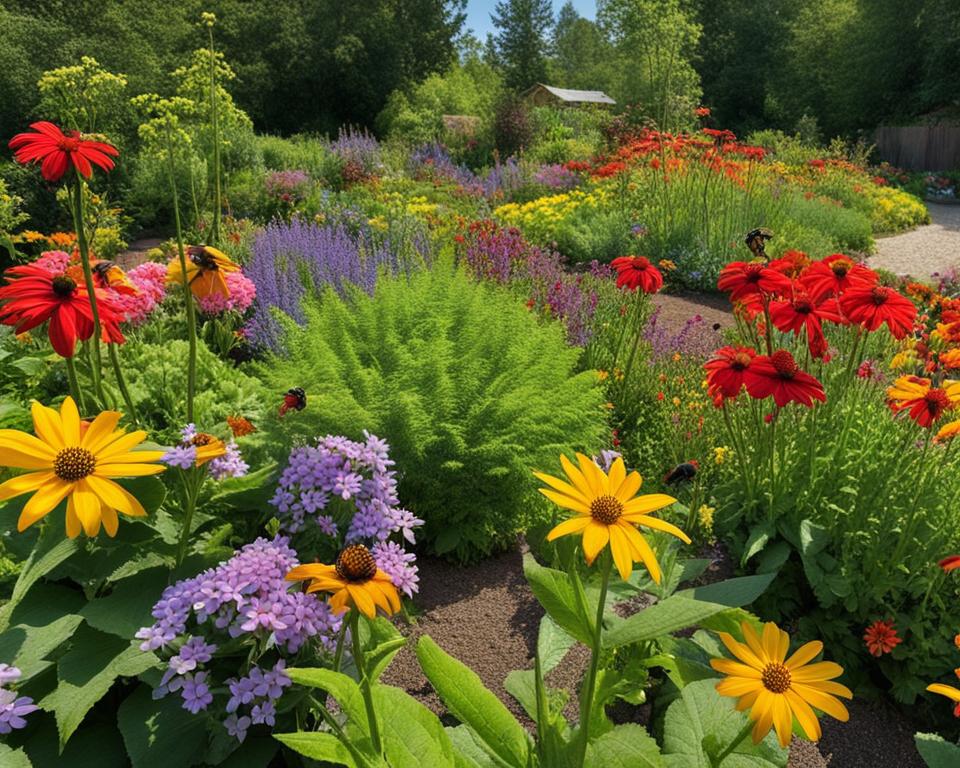
Conclusion
Urban gardening is not only a way to bring greenery into your small living space, but also a sustainable and eco-friendly practice that promotes a greener and healthier environment. By following the tips and techniques outlined in this guide, you can create a thriving urban garden that adds beauty to your home while contributing to a more sustainable world.
With a variety of urban gardening ideas, you can transform even the smallest balcony or rooftop into a green haven. Choose the right plants for your space, considering their size and sunlight requirements. Overcome challenges such as wind and pollution by selecting hardy and resilient plants. Make urban gardening affordable by taking advantage of cost-saving measures like seed swaps and free supplies from local organizations.
Adopt sustainable practices like water conservation, stormwater management, and attracting pollinators to create a thriving and biodiverse urban garden. By incorporating these practices, you can not only conserve water and reduce runoff, but also support important pollinator species and contribute to their conservation efforts.
So, whether you have a balcony, terrace, or small patch of dirt, take the plunge into the world of urban gardening. With a little creativity, planning, and a green thumb, you can create a sustainable urban garden that brings joy, beauty, and a connection to nature right to your doorstep.
FAQ
What are the best plants for an urban garden?
Look for plants labeled as “dwarf” or “miniature” with small footprints. Consider tall plants like columnar apple trees or Baptisia australis for added height.
How can I overcome challenges in urban gardening?
Choose hardy plants that can withstand wind and shade, and consider adding a lattice windbreak for protection. Opt for plants with shiny leaves to prevent dust buildup.
How can I make urban gardening affordable?
Take advantage of cost-saving opportunities like seed swaps and free supplies from local organizations. Attend gardening workshops at your local botanical garden for expert advice.
What is the Brooklyn Urban Gardeners (BUGs) program?
BUGs is a certification program offered by the Brooklyn Botanic Garden to train volunteers in community greening. Graduates commit to volunteering in community projects.
What are sustainable gardening practices for urban gardens?
Use integrated pest management, composting, water conservation techniques, and attract pollinators with native plants. These practices minimize harm to the environment.
How can I conserve water and manage stormwater in my urban garden?
Implement efficient watering methods and collect rainwater using rain barrels. Plant rain gardens and manage precipitation runoff to conserve water and prevent issues.
How can I attract pollinators and beneficial insects to my urban garden?
Plant flowers and native species that provide nectar and pollen. Create habitats and water sources for pollinators. Consider beekeeping to support conservation efforts.
How can I master urban gardening for my home?
Choose the right plants, overcome challenges, make it affordable, adopt sustainable practices, and create a thriving green space. Enjoy the joy of green living!

